Welcome to Tesla Motors Club
Discuss Tesla's Model S, Model 3, Model X, Model Y, Cybertruck, Roadster and More.
Register
Install the app
How to install the app on iOS
You can install our site as a web app on your iOS device by utilizing the Add to Home Screen feature in Safari. Please see this thread for more details on this.
Note: This feature may not be available in some browsers.
-
Want to remove ads? Register an account and login to see fewer ads, and become a Supporting Member to remove almost all ads.
You are using an out of date browser. It may not display this or other websites correctly.
You should upgrade or use an alternative browser.
You should upgrade or use an alternative browser.
What is this plug called?
- Thread starter Jansy123
- Start date
...Japanese Model S...purchased...in NZ...trying to get an 'at home' setup and something to charge if on the road...adaptors...
I am not at all an expert about Tesla in Oceania. But through researching my article on charge ports/plugs I've picked up a little expertise. That said, your first source of valid information should be Tesla sales and service in NZ and Tesla online (for Oceanian and Asian countries). Plus people (on TMC) who actually live there.
Nonetheless, for you (and others who may read this) here goes:
- You have a car (Model S) with a charging port that looks like this, correct?
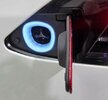 If so, it accepts only a Tesla Proprietary Connector (TPC) plug--the kind used in South Korea, Japan, North America, and until recently Taiwan. (It was the original charging standard developed by Tesla in America for Model S back in 2012.) This simple and elegant little port will accept both DC (on-the-road) and AC (home) charging equipment with the proper plug.
If so, it accepts only a Tesla Proprietary Connector (TPC) plug--the kind used in South Korea, Japan, North America, and until recently Taiwan. (It was the original charging standard developed by Tesla in America for Model S back in 2012.) This simple and elegant little port will accept both DC (on-the-road) and AC (home) charging equipment with the proper plug.
- But the two cable plug designs in NZ, Australia, and Europe look something like these, I believe:
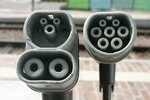 The one on the left is a (rather beat-up example of a) CCS Combo 2 (Type 2) plug that will now attach directly to a Tesla Model 3 (in Europe, Australia, and NZ). (To attach to a Model S in those countries an adapter and, for older cars, a hardware retrofit are needed.) I believe that some/many fast-charging DC stations in NZ will use this type of plug. (But as others mentioned, there are also CHAdeMO stations. See more on that below.)
The one on the left is a (rather beat-up example of a) CCS Combo 2 (Type 2) plug that will now attach directly to a Tesla Model 3 (in Europe, Australia, and NZ). (To attach to a Model S in those countries an adapter and, for older cars, a hardware retrofit are needed.) I believe that some/many fast-charging DC stations in NZ will use this type of plug. (But as others mentioned, there are also CHAdeMO stations. See more on that below.)
The one on the right is a Type 2 ("Mennekes") plug that will attach directly to Models S and X (in Europe, Australia, and NZ). These types of plugs are primarily used for AC power at home or on-the-road, (except that older Tesla Superchargers also used this type of plug for DC fast charging of Models S and X). But I believe that many Superchargers (in Europe and Oceania) have been updated to the plug on the left. Some Superchargers may have cables with both types of plugs? So maybe you will be still able to use older Superchargers (with a Type 2-to-TPC adapter)? (Check on that with Tesla and the adapter manufacturer.)
Regardless, neither plug will attach directly to your car (without modification or an adapter).
You need a plug that looks like this (photos using Model 3):
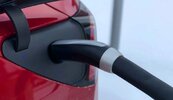
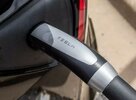
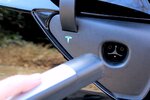 This is the Tesla TPC (proprietary) plug used in Japan South Korea, and North America.
This is the Tesla TPC (proprietary) plug used in Japan South Korea, and North America.
You would need an adapter (if such exists, which is doubtful) to go from CCS2-to-TPC (for DC fast charging), and one to go from Type 2-to-TPC for home and on-the-road AC charging.
- Do such adapters exist? Maybe only the Type 2 adapters.
- I think this may be a Type 2-to-TPC adapter:
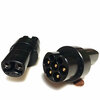 It is expensive. It may be only for AC charging, I am not sure. And you need to check with the company selling it to be sure it will work in New Zealand.
It is expensive. It may be only for AC charging, I am not sure. And you need to check with the company selling it to be sure it will work in New Zealand.
- Also, there is this Type 2-to-TPC adapter. I do not know the cost, where the seller is located, and the reliability of product and seller. Check.
- Finally, people and businesses in NZ may have better sources for the adapters you need. Start with Tesla of NZ.
- I think this may be a Type 2-to-TPC adapter:
- Is there a CCS2-to-TPC over-the-counter DC adapter? Maybe not. It could perhaps be built custom, but at what cost and would it work properly?
- CHAdeMO--what is it?
Based on what folks are saying (in Europe and NV/Aus), CHAdeMO may be your best bet for on-the-road DC fast(er than AC) charging. CHAdeMO is a DC charging standard created in Japan and still used in Europe, Oceania, North America, and parts of eastern.coastal Asia. The CHAdeMO plug is completely different from the TPC plug your car needs, so once again you would need an adapter. But be careful--there are at least two types of Tesla CHAdeMO adapters:
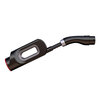
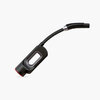 Note the different-sized plugs. The one on the left has a Type 2 plug. You don't want that for your car. You want the one on the right with the TPC plug, right? (I assume that Tesla CHAdeMO adapters with the TPC plug will work in any TPC car and in any CHAdeMO charging station.) Talk to Tesla and see if they can get you a CHAdeMO adapter with the TPC plug. When they are in stock they should still be available in South Korea, maybe Taiwan, and maybe Japan. With it you should be able to charge at all CHAdeMO stations in NZ (I assume). Unfortunately, CHAdeMO adapters with TPC plugs can be expensive and hard to find.
Note the different-sized plugs. The one on the left has a Type 2 plug. You don't want that for your car. You want the one on the right with the TPC plug, right? (I assume that Tesla CHAdeMO adapters with the TPC plug will work in any TPC car and in any CHAdeMO charging station.) Talk to Tesla and see if they can get you a CHAdeMO adapter with the TPC plug. When they are in stock they should still be available in South Korea, maybe Taiwan, and maybe Japan. With it you should be able to charge at all CHAdeMO stations in NZ (I assume). Unfortunately, CHAdeMO adapters with TPC plugs can be expensive and hard to find.
Also, older Model S may need some kind of hardware retrofit/upgrade in order to use a Tesla CHAdeMO adapter. This is important. Check with Tesla about this and see if your car needs that.
By the way, Tesla websites in countries that I know use Type 2 plugs (Europe, Australia, NZ) often picture a CHAdeMO adapter for sale on their respective websites with the TPC plug. I think this is just web-master laziness. The Tesla pdf owner's manuals on file for these countries do correctly show a Type 2 plug (which you can't directly use). If you can order a CHAdeMO adapter in NZ, be sure it has the TPC plug your car needs.
- Unless you can use two adapters simultaneously--CCS2-to-Type2 and Type 2-to-TPC--which I doubt, any Tesla adapter that goes from CCS2-to-Type 2 probably won't help you. (You need it to be CCS2-to-TPC.)
You would need an adapter (if such exists, which is doubtful) to go from CCS2-to-TPC (for DC fast charging)...Do such adapters exist?...(You need it to be CCS2-to-TPC.)
Followup: This seller may offer CCS2-to-TPC adapters that can work with either Superchargers (w/CCS2 cable-plugs) and/or third-party CCS2 DC charging stations in Europe. So perhaps they would also work in New Zealand and Australia?
However, caution is warranted. There appear to be two different CCS2 versions offered. Why? And note the statement: "CCS2 (Gen4) NOT working on V3 Supercharger." And there are other hardware and software requirements and restrictions, depending on the model-year. With certain hardware changes, there may be possible interference with subsequent CHAdeMO adapter usage. So be sure to check carefully with the seller before purchase to ensure that an adapter from this source will work with your model-year and what modifications may be necessary.
Thank you so much for all your information! I really appreciate itFollowup: This seller may offer CCS2-to-TPC adapters that can work with either Superchargers (w/CCS2 cable-plugs) and/or third-party CCS2 DC charging stations in Europe. So perhaps they would also work in New Zealand and Australia?
However, caution is warranted. There appear to be two different CCS2 versions offered. Why? And note the statement: "CCS2 (Gen4) NOT working on V3 Supercharger." And there are other hardware and software requirements and restrictions, depending on the model-year. With certain hardware changes, there may be possible interference with subsequent CHAdeMO adapter usage. So be sure to check carefully with the seller before purchase to ensure that an adapter from this source will work with your model-year and what modifications may be necessary.
Another thing to consider is I don't think Tesla NZ supports out of region imported cars, I could be wrong about that...
I have seen multiple charts of charging standards of the world. Few if any include the Tesla proprietary standard. I like the one you included, so I am working on a modified version here.
Zoltrix77
Member
I am not at all an expert about Tesla in Oceania. But through researching my article on charge ports/plugs I've picked up a little expertise. That said, your first source of valid information should be Tesla sales and service in NZ and Tesla online (for Oceanian and Asian countries). Plus people (on TMC) who actually live there.
Nonetheless, for you (and others who may read this) here goes:
- You have a car (Model S) with a charging port that looks like this, correct?
View attachment 767222 If so, it accepts only a Tesla Proprietary Connector (TPC) plug--the kind used in South Korea, Japan, North America, and until recently Taiwan. (It was the original charging standard developed by Tesla in America for Model S back in 2012.) This simple and elegant little port will accept both DC (on-the-road) and AC (home) charging equipment with the proper plug.
While I completely agree the plug is "elegant", I am so glad it was never adopted in EU/AU/NZ for the simple reason that it doesn't support 3phase AC charging. That would have been the biggest failing. Nearly all commercial AC charging locations are 11kW three phase. Its the only practical way for a commercial location to offer slow charging. The fact is that when you are doing most of your charging at home, you only ever use the Type 2 plug, which isn't much less elegant than the TPC.
In fact if I had it my way, even North America would use Type 2, it does everything and would have been one world wide standard.
Thank you so much for all your information! I really appreciate it
You are welcome.
The issue of moving with a car from one area (say, North America) to another (say, Europe). or in your case buying a car from another area (Japan) in another (New Zealand), is likely not commonplace, but probably happens occasionally. Please let us know how you eventually do, what solutions you arrive at, and what tips you have for others in similar circumstances.
EfficientWatts
Member
In fact if I had it my way, even North America would use Type 2, it does everything and would have been one world wide standard.
I think that's the big thing people forget is that even though the type 2 plug can do 3 phase, it doesn't have to do 3 phase. I think if type 2 was more set in stone before Tesla started there may have been a chance of Tesla taking it up, but I get the feeling it wouldn't as "bigger plug" would mean a higher "cost" on what would be wasted space for NA cars. But we will never know unfortunately.
Something that may be interesting to keep an eye on is as EVs get more popular, watch to see how automakers responds to US military and govt people (as well as some civilians) traveling overseas with their vehicles. With everything in NA using type 1 and pretty much everywhere else being type 2, it would be interesting to see how they respond to that. Right now it happens but it is relatively rare, which is why we haven't seen much issue raised about this. Unfortunately that probably won't help your immediate situation as I don't see such a critical mass happening in the US in the near future.
Matt_NZ
Member
For South Korea and North America your bigger problem is that the steering wheel is on the wrong side. If you're coming from there then 100% sell your current car and buy a new one here as you cannot bring a LHD car to NZ (outside of some very specific exceptions that only the Roadster would qualify for)So, after reading all this, for all folks pondering bringing a TPC Model S or X from South Korea, Japan, or North America to (Type 2) Oceania, is it safe to say: Consider getting an already Type 2 car there instead? Easier; cheaper?
RobDickinson
Active Member
You can absolutely bring a LHD model 3 or S to NZ, you just wont be able to drive it on public roads.
RobDickinson
Active Member
Matt_NZ
Member
Japan is a RHD country like New Zealand.
@RobDickinson I guess you're right, you could bring a LHD Tesla to NZ but it would be an expensive paddock car
@RobDickinson I guess you're right, you could bring a LHD Tesla to NZ but it would be an expensive paddock car
Hey everyone thanks for all the comments, I've really learnt a lot reading the discussion.
I have also come across this adapter, which is touted as allowing US plugs (like mine) to use EU Supercharger (Like NZ has also) the Superchargers on KRoad have the CCS2 and the Type-2 Mennekes with the little extra notch thing to presumably make them only work for Tesla's?
In any case the seller states "he has sold quite a few to NZ buyers and they work great" but I'm sure.he says that to all the girls
Has any one got thoughts on this adapter and it's chance of working? If it did, I'm sorted
Thank you

I have also come across this adapter, which is touted as allowing US plugs (like mine) to use EU Supercharger (Like NZ has also) the Superchargers on KRoad have the CCS2 and the Type-2 Mennekes with the little extra notch thing to presumably make them only work for Tesla's?
In any case the seller states "he has sold quite a few to NZ buyers and they work great" but I'm sure.he says that to all the girls
Has any one got thoughts on this adapter and it's chance of working? If it did, I'm sorted
Thank you
...I have also come across this adapter, which is touted as allowing US plugs (like mine) to use EU Supercharger (Like NZ has also) the Superchargers on KRoad have the CCS2 and the Type-2 Mennekes with the little extra notch thing to presumably make them only work for Tesla's?
...seller states "he has sold quite a few to NZ buyers...
...thoughts on this adapter and it's chance of working? If it did, I'm sorted...
My initial thoughts:
- From just the one photo, it appears to be an aftermarket or 3rd-party (meaning not original Tesla product) Type 2-to-TPC adapter.
- It might help us to know the:
- source (seller) and/or manufacturer,
- webpage address,
- country of origin,
- guarantee/warranty, if any, and
- the price.
- Is it one of the two Type 2-to-TPC adapters I referenced in Post #22, above? Looks similar to the first one, the EVSadapters,com version, which cost $777 (USD) on that webpage and is only for Supercharging (not for AC charging at home or on the road; a different adapter is needed for AC charging).
By the way, I am suspicious of the second Type 2-to-TPC adapter I referenced. It appears to come from Europe, but what really bothers me is that the price is not available until you "order" the adapter and supply information. I'd definitely use caution, or avoid that one.
- If it is a quality item, and we can't know that yet without more information, then it should allow you to charge your car with its TPC port from Superchargers with a Type 2 to plug. Do most Superchargers there still have a Type 2 cable-plug?
- This is where other New Zealand residents and Tesla New Zealand Sales/Service Centers should have the experience and answers you need.
- You are right to be cautious and to learn all you can before risking your car to a critical non-Tesla product. (That is a powerful current flowing through a Supercharger cable.)
- You said you might be all set if this adapter works. But do you have a good way to charge at home (using AC household electricity)? For many people charging overnight at home is the easiest and least expensive method for day-to-day driving. For many, fast DC fast charging is only necessary for long overnight trips. Many people (in the USA) hardly use Superchargers or other DC charging stations at all. But if you are going to be traveling, vacationing, sightseeing, et cetera with the car (And who wouldn't want to in beautiful New Zealand?), than yes, you probably need to charge on the road.
Last edited:
Thank you again! This adapter was via eBay here it seems to be one of a few providers. It's a bit of an expensive buy if it arrives here and does not work. My safest bet would be to try to connect with someone who has tried here locally (anyone?My initial thoughts:
- From just the one photo, it appears to be an aftermarket or 3rd-party (meaning not original Tesla product) Type 2-to-TPC adapter.
- It might help us to know the:
- source (seller) and/or manufacturer,
- webpage address,
- country of origin,
- guarantee/warranty, if any, and
- the price.
- Is it one of the two Type 2-to-TPC adapters I referenced in Post #22, above? Looks similar to the first one, the EVSadapters,com version, which cost $777 (USD) on that webpage and is only for Supercharging (not for AC charging at home or on the road; a different adapter is needed for AC charging).
By the way, I am suspicious of the second Type 2-to-TPC adapter I referenced. It appears to come from Europe, but what really bothers me is that the price is not available until you "order" the adapter and supply information. I'd definitely use caution, or avoid that one.
- If it is a quality item, and we can't know that yet without more information, then it should allow you to charge your car with its TPC port from Superchargers with a Type 2 to plug. Do most Superchargers there still have a Type 2 cable-plug?
- This is where other New Zealand residents and Tesla New Zealand Sales/Service Centers should have the experience and answers you need.
- You are right to be cautious and to learn all you can before risking your car to a critical non-Tesla product. (That is a powerful current flowing through a Supercharger cable.)
- You said you might be all set if this adapter works. But do you have a good way to charge at home (using AC household electricity)? For many people charging overnight at home is the easiest and least expensive method for day-to-day driving. For many, fast DC fast charging is only necessary for long overnight trips. Many people (in the USA) hardly use Superchargers or other DC charging stations at all. But if you are going to be traveling, vacationing, sightseeing, et cetera with the car (And who wouldn't want to in beautiful New Zealand?), than yes, you probably need to charge on the road.
At home I've resided to a 16a 'blue plug' charger that already has a type 1 to Tesla adapter. This has been my only charger for the past month and works perfectly for slower AC charging.
The charger I have is variable current so can also be set to 8amp and connecting another adapter allows for a wall plug use also.
I'll be the first to admit that it's all a bit clunky..!
I tried to explore a 32amp wall charger that allows for type 1 and 2 cables. Unfortunately my home electrics max out at 63amp so I was advised I would rarely if ever get the full benefit of this install and cost and could mainly run at 16amp anyway
Eitherway my at home is ok for now.
I have not ruled out Chademo to teslaUS adapter you mention above but they seem very hard to source and quite expensive.
Like most new owners I want to try to get all my bases covered but just have complexity of an out of market vehicle to try to solve.
My car says it's has lifetime unlimited supercharging and has the code SC01 in the 'look up' .. but I still don't/won't know if that.part.even works here untill I can connect to the supercharger network. I realise there is a big chance it will not. But paying for a fast charge is ok by me too. This is where Chademo could be an even better option as that is avail on fast chargers in many places (100kw+)
Matt_NZ
Member
This is why I think Tesla should offer an affordable official retrofit for Japanese imports in New Zealand to avoid people being forced into buying dodgy adapters off the internet that may or may not damage the Superchargers, the car or injure/kill the owner.
Like it or not, Tesla needs to come to terms with the fact that New Zealand is rather reliant on Japanese imports for its second hand car market. This problem isn't going to go away and having a policy of "don't buy Japanese imports" isn't sustainable.
This might not be popular, but I think that charge port compatibility needs to be incorporated into the Certification/WoF process and legislation that requires OEMS to provide conversion options. Otherwise as these become more popular I think someone is going to get injured.
Like it or not, Tesla needs to come to terms with the fact that New Zealand is rather reliant on Japanese imports for its second hand car market. This problem isn't going to go away and having a policy of "don't buy Japanese imports" isn't sustainable.
This might not be popular, but I think that charge port compatibility needs to be incorporated into the Certification/WoF process and legislation that requires OEMS to provide conversion options. Otherwise as these become more popular I think someone is going to get injured.
NZ is predominantly a second hand car market and Japan provides much of the stock. It would actually make pretty good sense that as part of the compliance process, charge port compatibility is a requirement.
But maybe the Japanese will move to CCS2 standardisation too over time? It's a bulky plug/port though.
Good call though Matt
But maybe the Japanese will move to CCS2 standardisation too over time? It's a bulky plug/port though.
Good call though Matt
RobDickinson
Active Member
Similar threads
- Replies
- 3
- Views
- 447
- Replies
- 3
- Views
- 863
- Replies
- 1
- Views
- 416
- Replies
- 14
- Views
- 1K
- Replies
- 0
- Views
- 420


